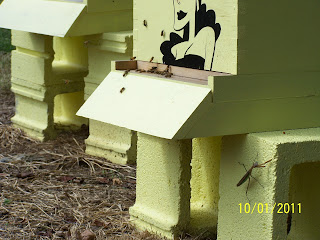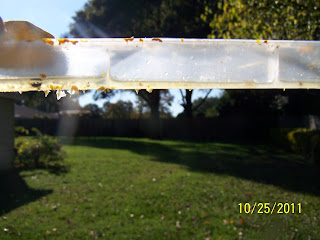written by Tom D.
I know it's been a long time since I put a bee post here, but work has continued to prep the girls for winter. I also received my official NC Certified Beekeeper certificate from the state, and was elected VP of the Mecklenburg County Beekeepers. Lots has been going on. :)
In September, a month had passed since the split. I fed them heavily with thin syrup, and they were at close to full strength in just a month. As you can see there was lots of bees to be found. This is Hive Boris, who appeared to be doing quite well.
A nice frame of bees and brood in a beautiful compact circle. The queen was doing well and laying lots of eggs which I found on this inspection.
In October I was surprised to find one of my bees on a cabbage head. What was she doing? I looked more closely and she and other bees were drinking morning dew collected by the leaves. I realized I needed to replenish the bird baths nearby so they could get water in.
Work continued on both hives in prep for the winter. I continued feeding, but switched to heavy syrup on my plastic top feeders. The heavy syrup crystallized like crazy in my top feeders and became a pain. I suspect that stirring the sugar once it got to the melting stage in the water might have been to blame for the crystallization. I'll find that out next fall.
While the bees were bringing in tons of goldenrod and aster pollen, strange critters started showing up like this praying mantis.
She seemed to be missing one of her legs but it didn't seem to slow her down much. Those eyes are freaky!
Pollen, pollen, pollen! I left the mouse guard on both hives ever since my late summer split, and will keep them on until Spring 2012.
One of my last inspections. The top of Boris. Each deep box had at least 6.5 frames of syrup honey. Since I use 9 frames in a 10-frame box, the comb is drawn out deeper, holding much more honey in its cells. It's part of my winter strategy. I made the dubious error of picking up the top box of Natasha, forgetting that each honey frame weighs about 9.5 pounds each. My back and left forearm still haven't forgotten! Lesson learned: use a work box, goofy! All was quiet up top. It was the end of October and time to make my last inspection of 2011.
Some bur comb needed to be cleaned up. I removed the beetle traps since only one or two seemed to be in them. Hopefully that wasn't a mistake for winter.
One dead small hive beetle.
A beautiful capped honey frame, that still wasn't fully drawn out.
Things were a bit of a mess. More cleanup. After seeing how messy the interior can get in just a few weeks, I realized that initial inspections in Spring will mean lots of cleanup, removing burr comb and excess propolis.
Another honey frame with a side only a third drawn out. Each box on both hives had about 6.5 honey frames each, or about 13 per hive. That means each hive will have about 120 pounds of food for the winter. So far it's been a mild one, so they should survive easily and not starve to death. We only need about 50-70 pounds per hive here in the mild climes of Carolina, I've been told. The hives were packed with pollen. It fell out of the cells as I turned the frames over to inspect them. Fortunately the pollen fell back inside the colonies.
Here they're working on evaporating that syrup down and starting to cap it. The freshly drawn comb is so beautifully white.
Okay, I'm beginning to overstay my welcome. Hive Natasha had a ton of burr comb built between the boxes, and they didn't take too kindly to me interrupting their work. Fall bees became nasty, aggressive bees. They get quite defensive, I found out on more than one occasion! I also brought bales of wheat straw in for winter wind breaks.
A larvae fell out of one of the burr comb cells, and she was swiftly snatched down into the hive by some nurse bees.
My bees seem to be VERY attached to their beekeeper. This solo girl on our back screen porch was saying "Goodbye 2011!" or "Let me in, it's getting a little cool out here!!"
Here you can see my final winter bee yard. I put up the straw wind breaks on the outside of both hives and one each at the back and front. I left on my summer screened inner cover at the top and screened bottom board to allow for lots of ventillation. This will keep the hives from being killed off by the freezing condensation that can drip down onto them if air flow is constricted. I believe we have to make strong colonies so they can keep themselves warm, not keep a warm hive, which can lead to the bees eating too much food and eventually starving during the winter months.
Here you can see the girls in late December on an unusually mild day of mid-50s coming in from foraging for pollen (they actually were coming in with some bright gold and a little bit of white pollen ... where were they getting that?). LOTS of orientation flights were taking place it seemed, too. You can also see my straw bales setup. I've since moved the side bales to about 5 feet away, since they're there for a wind break only. I couldn't believe how many flight were going on in late December. They seem to be taking off at 53 degrees. I've seen pollen coming in at the mid-50s degree range this winter.
That should do it until early Spring, which is right around the corner in just another month and a half. Hopefully I'll find I was successful in over-wintering my first two hives, thus making me a beekeeper and not a bee-haver. One of my mentors, Hernan, thinks I'm crazy for putting up the bales, calling them unnecessary. We'll see if I'm crazy ... like a fox (or not)!


















